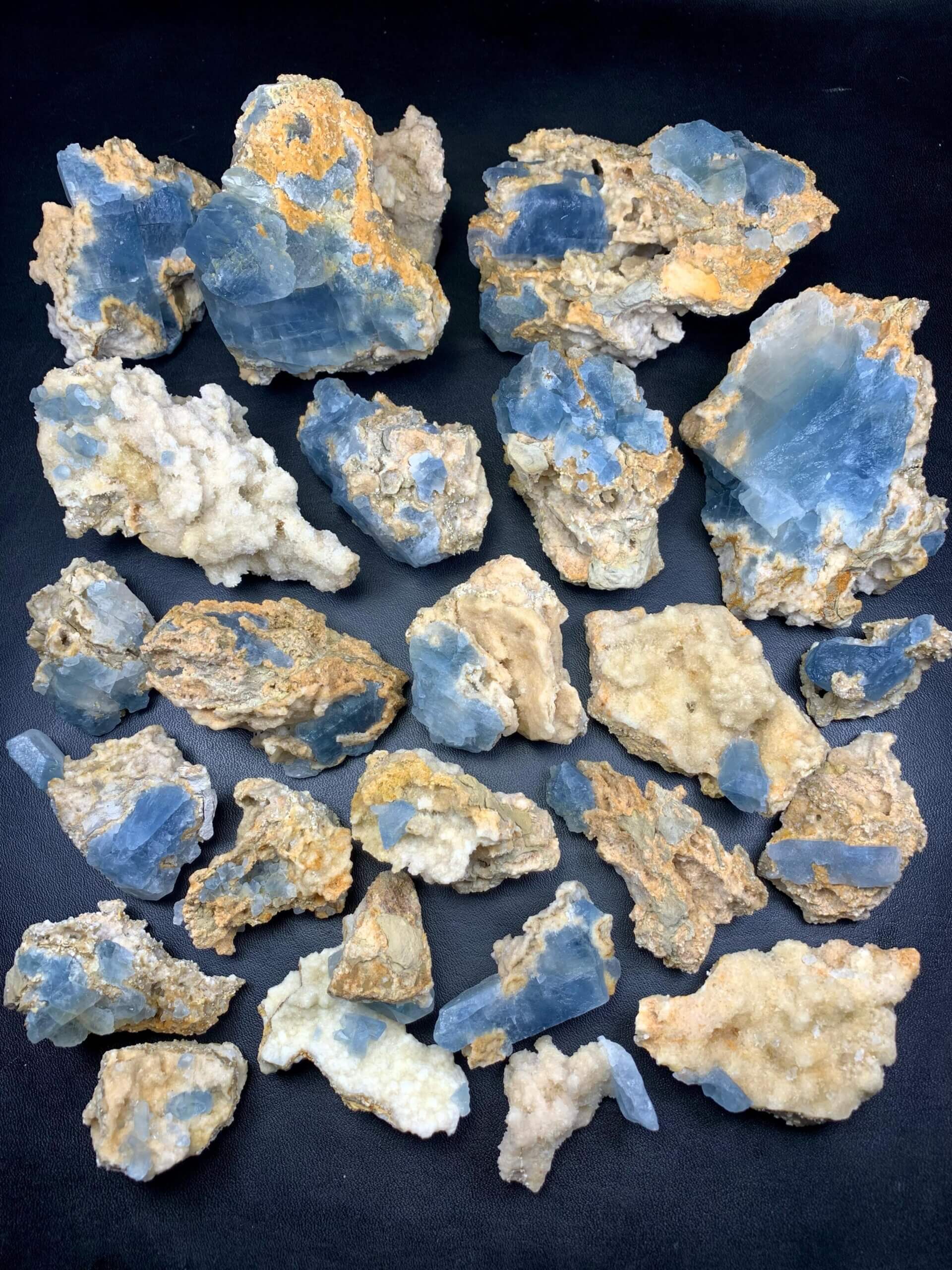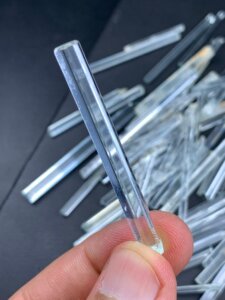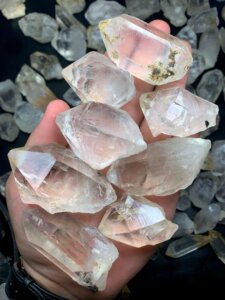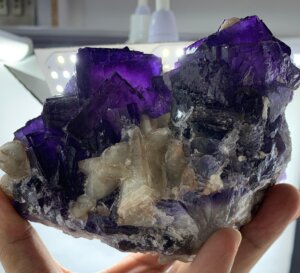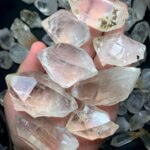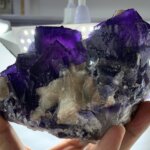Celestine, also known as Celestite, is one of the most enchanting minerals in the world — prized for its delicate sky-blue hue and tranquil energy. A natural color Celestine crystal specimen is not only a mesmerizing display piece but also a valuable addition to any mineral collection. Found in select regions across the globe, including Badakhshan, Afghanistan, these specimens are admired by collectors, jewelers, and crystal enthusiasts alike.
In this detailed guide, we’ll explore everything you need to know about natural color Celestine crystal specimens — from their formation and properties to care, buying tips, and collector insights. Whether you’re a seasoned mineral enthusiast or a new buyer looking to invest in authentic Afghan Celestine, this article is your one-stop resource.
What Is a Natural Color Celestine Crystal Specimen?
A natural color Celestine crystal specimen is a cluster or single crystal formation of the mineral Celestine (chemical formula: SrSO₄, or strontium sulfate). The term “natural color” refers to its authentic, unenhanced blue tone, formed naturally over millions of years without artificial treatment or dyeing.
Unlike artificially colored stones, natural Celestine showcases a subtle yet captivating blue — reminiscent of the sky at dawn — that varies from pale ice-blue to deep azure depending on the specimen’s location and geological conditions.
Why Collectors Love Natural Celestine
- Aesthetic appeal: Its gentle, glassy luster and ethereal color make it one of the most photogenic minerals.
- Rarity: Top-quality specimens, especially from Afghanistan and Madagascar, are increasingly rare.
- Metaphysical energy: Many believe Celestine promotes peace, mental clarity, and spiritual awareness.
- Decorative beauty: Perfect for display in homes, offices, or healing spaces.
Geological Formation and Origins
Celestine forms in sedimentary rock environments, often within limestone and dolomite deposits. It crystallizes from evaporating seawater rich in strontium sulfate, forming delicate prismatic or tabular crystals. Over time, these crystals develop within geodes or cavities, sometimes alongside minerals like calcite, gypsum, or fluorite.
Major Sources of Celestine
- Badakhshan, Afghanistan: Famous for producing blue Celestine crystals with exceptional transparency and natural color.
- Madagascar: Known for large, pale-blue clusters often used in home décor and metaphysical use.
- Ohio, USA: One of the earliest known sources, particularly in the famous Crystal Cave.
- Mexico & Spain: Produce small but vibrantly colored specimens.
Among these, Afghan Celestine specimens stand out for their purity, sharp crystal formations, and deep natural color, making them a favorite among international collectors.
Physical and Optical Properties of Celestine
| Property | Details |
|---|---|
| Chemical Formula | SrSO₄ (Strontium Sulfate) |
| Crystal System | Orthorhombic |
| Hardness | 3 to 3.5 on Mohs scale |
| Luster | Vitreous to pearly |
| Transparency | Transparent to translucent |
| Cleavage | Perfect in one direction |
| Specific Gravity | 3.9 to 4.0 |
| Common Colors | Sky blue, white, colorless, pale yellow |
Celestine’s softness makes it delicate and brittle, so proper care and handling are essential. Its glassy luster and pale coloration make it ideal for display pieces, rather than jewelry subjected to frequent wear.
Metaphysical and Healing Properties
While Celestine’s scientific beauty is undeniable, many crystal healers and spiritual practitioners value it for its energetic properties:
- Calming energy: Promotes serenity and inner peace.
- Spiritual connection: Often associated with the throat and crown chakras, aiding communication and divine intuition.
- Stress relief: Used during meditation to relieve anxiety and enhance mindfulness.
- Sleep aid: Some keep Celestine near the bed to encourage restful sleep and vivid dreams.
💡 Tip: Place your natural color Celestine crystal specimen near natural light to amplify its soothing energy and appreciate its blue brilliance.
How to Identify a Genuine Natural Color Celestine Specimen
As demand for Celestine grows, so does the risk of imitation or artificially enhanced stones. Here’s how to ensure authenticity:
1. Observe the Color
Natural Celestine has a soft, gentle blue — never overly bright or uniform. Artificially dyed specimens often display an unnatural, even tone.
2. Check Transparency and Texture
Authentic Celestine tends to have translucent edges with a glassy luster. The crystals are usually prismatic or tabular with visible striations.
3. Ask About Origin
Reputable sellers provide location details (e.g., Badakhshan, Afghanistan; Madagascar). Origin transparency is a strong authenticity indicator.
4. Look for Matrix Material
Natural clusters often come on limestone or dolomite matrix, whereas fakes or reconstituted pieces lack a natural base.
Caring for Your Celestine Specimen
Celestine is delicate and water-soluble, so special care is needed to maintain its beauty:
Cleaning Tips
- Avoid water — never soak or rinse Celestine under running water.
- Use a soft, dry brush or compressed air to remove dust.
- Keep away from direct sunlight for long periods, as UV exposure may fade the color.
Storage Tips
- Store separately in a padded box or display case.
- Avoid contact with harder minerals that may scratch it.
- Maintain moderate humidity levels to prevent surface damage.
Buying Guide: Choosing the Right Celestine Crystal Specimen
When buying a natural color Celestine crystal specimen, consider these key factors:
1. Origin and Authenticity
Look for genuine Afghan Celestine specimens or those from Madagascar for top visual appeal. Always buy from trusted mineral dealers with verified sourcing.
2. Color and Clarity
The richer and more even the natural blue, the more valuable the specimen. Avoid overly pale or cloudy crystals if you’re seeking high-grade collector pieces.
3. Size and Formation
- Small clusters are perfect for décor and crystal therapy.
- Large geodes or single crystals are prized by collectors for display value.
4. Price Range
Celestine is relatively affordable but varies based on quality:
- Small raw pieces: $10–$50
- Medium clusters: $50–$150
- High-quality Afghan specimens: $200–$600+ depending on size and depth of color
5. Trusted Online Sellers
When shopping online, verify:
- Authentic photos (no color enhancement).
- Clear mention of origin (e.g., Natural color Celestine specimen from Badakhshan, Afghanistan).
- Buyer reviews and secure payment options.
Celestine in Jewelry and Home Décor
Although Celestine’s softness limits its use in jewelry, small polished pieces or protected pendants can make stunning accessories. More commonly, Celestine clusters are displayed in homes, meditation rooms, and offices as symbols of calmness and clarity.
Decorators love using blue Celestine geodes in interior design — pairing them with neutral backgrounds to highlight their ethereal beauty.
Celestine vs. Other Blue Minerals
| Mineral | Color Tone | Hardness | Key Difference |
|---|---|---|---|
| Celestine | Sky blue | 3–3.5 | Softer, translucent, peaceful hue |
| Blue Calcite | Soft blue | 3 | More opaque, waxy surface |
| Blue Barite | Grayish-blue | 3–3.5 | Tabular crystals, heavier |
| Kyanite | Deep blue | 4.5–7 | More durable, fibrous appearance |
Celestine’s gentle, natural color sets it apart from other blue minerals — making it instantly recognizable to collectors.
FAQs About Natural Color Celestine Crystal Specimens
1. Is Celestine the same as Celestite?
Yes. Both names refer to the same mineral — Celestine (SrSO₄). The name “Celestite” is more common in the metaphysical market, while “Celestine” is used in mineralogy.
2. Can Celestine be used in jewelry?
Only in protected designs such as pendants or display pieces. Due to its low hardness, it’s unsuitable for rings or bracelets.
3. Does Celestine fade over time?
Yes, prolonged sunlight exposure may cause fading. Store it away from direct UV light to maintain its natural blue color.
4. What makes Afghan Celestine special?
Afghan Celestine, especially from Badakhshan, is valued for its vivid natural blue color, clarity, and well-formed crystals rarely seen elsewhere.
5. How can I tell if my Celestine is dyed?
Dyed Celestine often has unnaturally bright or uniform blue hues and may stain when rubbed with a damp cloth — a sign of artificial treatment.
Conclusion: Why You Should Own a Natural Color Celestine Crystal Specimen
Owning a natural color Celestine crystal specimen is like holding a piece of the sky in your hands. Whether displayed in your collection, used for meditation, or admired for its geological wonder, each specimen carries millions of years of Earth’s artistry.
For collectors, Afghan Celestine offers unmatched quality and rarity. For buyers, it’s an affordable gateway into the world of fine mineral specimens.
✨ Ready to explore or purchase your own Celestine crystal?
Discover authentic natural color Celestine specimens from Badakhshan, Afghanistan — each piece ethically sourced and naturally beautiful.
